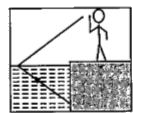Assertion :- In telophase chromosomes that have reached their respective poles, lose their individuality
Reason:- In normal condition (Interphase) genetic material exists in form of chromatin material instead of chromosome.
If both Assertion & Reason are True & the Reason is a correct explanation of the Assertion.
If both Assertion & Reason are True but Reason is not a correct explanation of the Assertion
If Assertion is True but the Reason is False
If both Assertion & Reason are false.
The correct Answer is:A
Step by step video, text & image solution for Assertion :- In telophase chromosomes that have reached their respective poles, lose their individuality Reason:- In normal condition (Interphase) genetic material exists in form of chromatin material instead of chromosome. by Biology experts to help you in doubts & scoring excellent marks in Class 12 exams.
Topper's Solved these Questions
- BOOK - MOTIONCHAPTER - CELL CYCLE AND CELL DIVISIONEXERCISE - Exercise - 4(AIIMS - 2016)1videos
CELL CYCLE AND CELL DIVISION
- BOOK - MOTIONCHAPTER - BREATHING AND EXCHANGE OF GASESEXERCISE - Exercise 421videos
BREATHING AND EXCHANGE OF GASES
- BOOK - MOTIONCHAPTER - CELL THE UNIT OF LIFEEXERCISE - Excercise - 4 AIIMS | Assertion & Reason Questions39videos
CELL THE UNIT OF LIFE
Similar Questions
Assertion : Translocations involve shifting, not deleting or adding genetic material which can cause chromosomal defects when gametes are formed.
Reason : Translocation involve transfers of genetic material between homologous chromosomes.View SolutionAssertion (A) :- polytene chromosomes have a high amount of DNA .
Reason( R) :- poly chromosomes are formed by repeated chroomtids.View Solution
Knowledge Check
- Question 1 - Select One
In which stage, the chromosomes that have reached their respective poles decondense and lose their individuality
AProphaseBMetaphaseCAnaphaseDTelophase - Question 2 - Select One
Assertion: Crossing over leads to recombination of genetic material on the two chromosomes.
Reason: Crossing over is the exchange of genetic material between two homologous chromosomes.AIf both assertion and reason are true and reason is the correct explantion of assertionBIf both assertion and reason are true but reason is not the correct explnantion of assertion.CIf assertion is true but reason is false.DIf both assertion and reason are false. - Question 3 - Select One
Assertion : Crossing over take place during pachytene stage.
Reason : It is a process of interchange of chromatid material between non sister chromatid of homologous chromosomes.AIf both Assertion & Reason are True & the Reason is a correct explanation of the Assertion.BIf both Assertion & Reason are True but Reason is not a correct explanation of the Assertion.CIf Assertion is True but the Reason is False.DIf both Assertion & Reason are false.
Assertion (A). Events in pachytene play a key role in evolutionary changes in organisms
Reason(R).Exchange of genetic material takes place between sister chromatids of homologous chromosomesView SolutionAssertion (A): A karyotype of 45 with X0 is the key genetic diagnostic point incase of an individual suffering from the Turner's syndrome.
Reason ( R): It is caused due to the presence of an additional copy of the chromosome number 21.View SolutionAssertion.Shortening of chromosomes in prophase proves advantageous in anaphase.
Reason.It is easier for short chromosomes to move to the opposite poles through the cytoplasm than it is for long.twisted interphase chromosomes.View SolutionIn each of the following questions two statements are given. One of them is assertion A and the other is reasoning R.
Assertion: When in the cell the amount of DNA material is increased in comparison to the RNA. meiosis is found to occur.
Reason: It maintains a definite and constant num-ber of the chromosomes in an organism.View SolutionNegative Refractive Index:
One of the most fundamental phenomena in optics is refraction. When a beam of light crosses the interface between two different materials, its path is altered depending on the difference in the refractive indices of the materials. The greater the difference, the greater the refraction of the beam. For all known naturally occurring materials the refractive index assumes only positive values. But does this have to be the case?
In 1967, Soviet physicist Victor Veselago hypothesized that a material with a negative refractive index could exist without violating any of the laws of physics.
Veselago predicted that this remarkable material would exhibit a wide variety of new optical phenomena. However, until recently no one had found such a material and Veselago's ideas had remained untested. Recently, meta-material samples are being tested for negative refractive index. But the experiments show significant losses and this could be an intrinsic property of negative index materials.
Snell's law is satisfied for the material having a negative refractive index, but the direction of the refracted light ray is 'mirror-imaged about the normal to the surface.

There will be an interesting difference in image formation if a vessel is filled with "negative water" having refractive index - 1.33 instead of regular water having refractive index 1.33.
Say, there is a fish in a vessel filled with negative water. The position of the fish is such that the observer cannot see it due to normal refraction since the refracted ray does not reach to his eye.

But due to negative refraction, he will be able to see it since the refracted ray now reaches his eye.
A ray in incident on normal glass and. "Inegative glass" at an angle 60∘. If the magnitude of angle of refraction in normal glass is 45∘ then, what will be the magnitude of angle of refraction in the "negative glass"?View Solution
